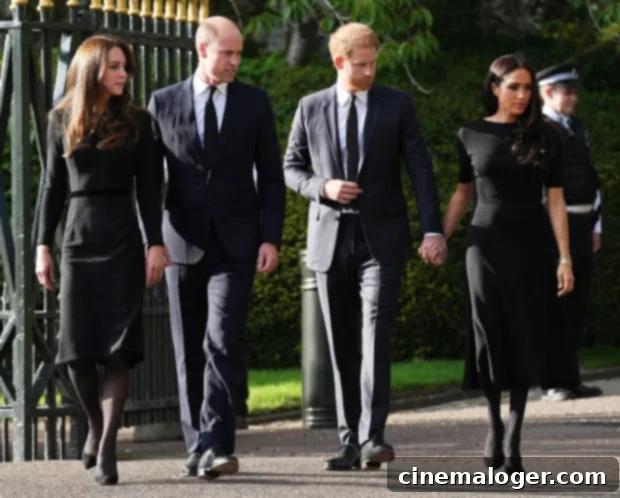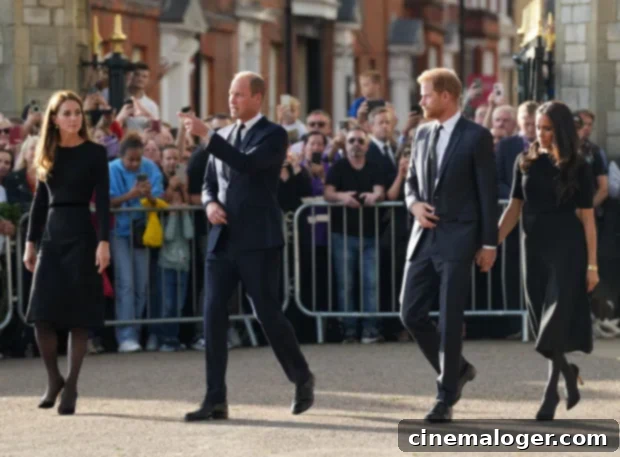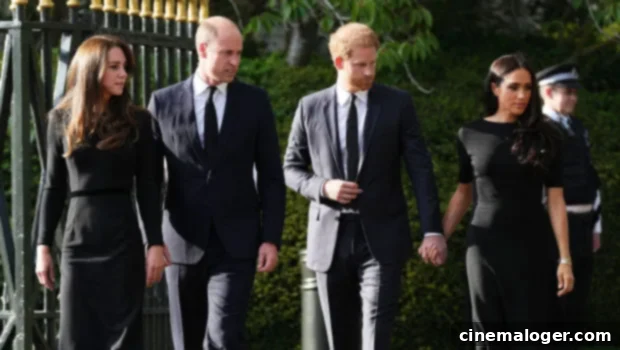Royal Unity in Grief: William, Kate, Harry, and Meghan Reconcile Amidst National Mourning for Queen Elizabeth II
The passing of Her Majesty Queen Elizabeth II on September 8, 2022, marked a profoundly somber moment for the United Kingdom and the Commonwealth, ushering in a period of intense national mourning and significant royal transition. As the world reeled from the news of the monarch’s death at Balmoral Castle, attention naturally turned to the Royal Family, who found themselves at the heart of public grief and ceremonial duties. In an unexpected yet deeply symbolic gesture of unity, Prince Harry and Meghan Markle were seen reuniting with Prince William and Kate Middleton outside Windsor Castle on Saturday, September 10. This joint appearance, dubbed the “Windsor Walkabout,” sent ripples across the globe, signifying a poignant moment of familial reconciliation and a united front in a time of shared sorrow.
The foursome emerged together, greeting hundreds of well-wishers and viewing the vast array of floral tributes, cards, and gifts left by the public in honor of the lateQueen Elizabeth II. The sight of the two brothers and their wives together was a powerful image, given the well-documented strains in their relationship over recent years. A statement released by Buckingham Palace confirmed the intentional nature of this reunion, with a royal spokesperson stating that William, now known as the Prince of Wales, “invited the Duke and Duchess of Sussex to join him and the Princess of Wales” for this public display of respect. This unprecedented invitation underscored a desire for solidarity within the monarchy during a period of immense change and emotional vulnerability.

The invitation itself carried immense significance, highlighting the deep desire for unity in the immediate aftermath of the Queen’s death, especially considering the considerable tension that had characterized relations between the two royal households in recent times. Following Harry and Meghan’s decision to step back from royal duties and relocate to the United States in early 2020, interactions between the couple and other senior members of the Royal Family had been minimal and often fraught with public scrutiny. Their move, affectionately dubbed “Megxit” by the media, initiated a period of distance, punctuated by revealing interviews and personal accounts that further complicated the family dynamic. The Sussexes were already in the U.K. for a series of charity events when the sad news of the Queen’s passing broke. However, as previously reported by various outlets, there were no pre-arranged plans for them to meet with William and Kate during their visit. This impromptu reunion, therefore, was a stark and emotional departure from the established status quo, prompted by the gravity of the Queen’s death and the collective need for a united front.
The Windsor Walkabout was a meticulously observed event, both by the public present and by millions watching worldwide. For nearly 40 minutes, the four royals engaged with the crowds, accepting condolences, admiring the floral tributes, and offering words of comfort. Their presence together conveyed a powerful message of continuity and resilience, assuring the public that even amidst profound personal grief, the Royal Family remained steadfast. This display of cohesion was particularly vital as the nation began to navigate a future without its beloved monarch, emphasizing that family bonds, even strained ones, could be prioritized in moments of national crisis.
This deeply moving reunion took place just hours after Prince William witnessed a pivotal moment in British history: the Accession Ceremony. During this ancient and solemn event, his father, King Charles III, was officially proclaimed the sovereign. Just two days after the death of his mother, the former Prince of Wales was elevated to the throne in an elaborate, centuries-old ceremony, rich in tradition and symbolism. This historic event, which unfolded at St. James’s Palace in London, was broadcast live for the very first time, allowing people across the globe to witness the formal declaration of a new reign and the smooth, constitutional transfer of power.

The Accession Council, a ceremonial body, first convened without King Charles III in the state apartments at St. James’s Palace. Senior British politicians, including the newly appointed Prime MinisterLiz Truss, and Privy Councillors formally acknowledged Charles’s new title as King Charles III. Following this, the King was invited to join the ceremony, where he solemnly took his vows, committing himself to his duties as the monarch. Among his immediate responsibilities was the formal declaration of the day of his mother’s funeral as a public holiday. This pivotal national event was later confirmed to take place on Monday, September 19, allowing the nation to collectively mourn and pay its final respects.
During the historic ceremony, the first of its kind since 1952 when Queen Elizabeth II ascended to the throne, King Charles III delivered a deeply personal and poignant address. He acknowledged the immense weight of his new role, stating, “I am deeply aware of this great inheritance and of the duties and heavy responsibilities of sovereignty which have now passed to me.” His words resonated with a sense of both duty and profound grief. He then movingly referenced the irreparable loss of his mother, who had recently celebrated her Platinum Jubilee, a testament to her unprecedented 70-year reign. “I know how deeply you and the entire nation, and I think I may say the whole world, sympathize with me in this irreparable loss we have all suffered,” he conveyed, expressing a shared sorrow that transcended national borders and connected him with his people in their collective grief.
The period of national mourning was marked by an extraordinary outpouring of grief and tribute from across the United Kingdom and around the globe. Crowds gathered in their thousands outside Buckingham Palace, Windsor Castle, and Balmoral Castle in Scotland, where the Queen passed away. Flowers, handwritten notes, drawings, and candles created vast carpets of remembrance, transforming these royal residences into spontaneous memorials. This communal expression of sorrow underscored the deep affection and respect held for Queen Elizabeth II, who had been a constant and unwavering presence in the lives of generations. The public’s desire to share their grief and pay their respects highlighted her unique connection with her subjects and her role as a unifying figure.
View this post on InstagramA post shared by Windsor Royal Family (@windsor.royal.family)
As the nation mourned, elaborate plans were set in motion for the Queen’s final journey. Her body was brought from Balmoral Castle to Edinburgh, and then conveyed to London. In a solemn procession, she lay in state at Westminster Hall, allowing hundreds of thousands of members of the public to file past her coffin and pay their personal respects. This tradition, dating back centuries, provided a final opportunity for the British people to bid farewell to their monarch. The funeral service itself, a grand and historic event befitting her extraordinary reign, took place at Westminster Abbey, bringing together world leaders, dignitaries, and members of the Royal Family from across the globe to honor her memory.
The Windsor Walkabout, occurring amidst these momentous events, will likely be remembered as a defining moment in the early days of King Charles III’s reign. It demonstrated the Royal Family’s capacity for unity and adaptability, even in the face of deep personal sorrow and complex internal dynamics. For Prince William and Prince Harry, this joint appearance was more than just a public duty; it was a powerful statement of solidarity, reminding the world that despite past differences, they remain brothers, bound by blood, shared history, and their unwavering commitment to the monarchy and their late grandmother’s legacy. This moment of reconciliation, however temporary, offered a glimmer of hope for future harmony within the Royal Family, as they navigate a new chapter under King Charles III and continue to serve the nation.
